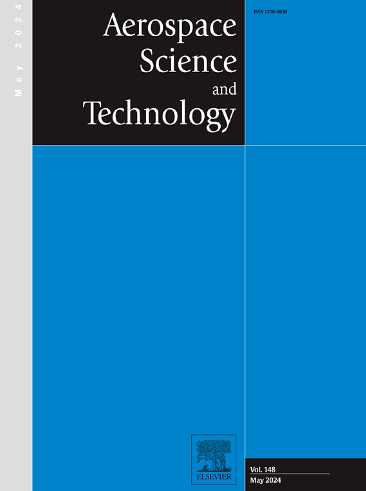Investigation on transonic buffet of airfoil within ground effect
IF 5
1区 工程技术
Q1 ENGINEERING, AEROSPACE
引用次数: 0
Abstract
Due to the complex interaction between shocks, boundary layers, and ground, vehicles are prone to experiencing dynamic buffet during transonic near-ground flight, posing a significant threat to flight safety. The numerical simulations are conducted at a Mach number of 0.8 to investigate the dynamic characteristics of transonic buffet within ground effect. Various angles of attack are considered, with a relative flight height (h/c, the ratio of height to chord length) of 0.2 and a Reynolds number of 1.86 × 107. Comprehensive analyses of force behaviors, pressure fluctuations, and momentum transport mechanisms are performed. The interference between shockwave motion and vortex shedding is analyzed by means of Dynamic Mode Decomposition (DMD) algorithm. Three distinct types of flow topologies are identified, corresponding to different angles of attack and characterized by the structures and dynamic characteristics. At low angles of attack, Mach reflection occurs between the lower surface and ground, forming the λ-shaped shock. The oscillations of shocks are synchronous with the shedding of vortices. At moderate angles of attack, however, the correlation between shockwave motion and vortex shedding becomes insignificant. At high angles of attack, the frequency of shockwave motion is approximately double that of the vortex shedding frequency, highlighting a distinct dynamic interaction.
求助全文
约1分钟内获得全文
求助全文
来源期刊

Aerospace Science and Technology
工程技术-工程:宇航
CiteScore
10.30
自引率
28.60%
发文量
654
审稿时长
54 days
期刊介绍:
Aerospace Science and Technology publishes articles of outstanding scientific quality. Each article is reviewed by two referees. The journal welcomes papers from a wide range of countries. This journal publishes original papers, review articles and short communications related to all fields of aerospace research, fundamental and applied, potential applications of which are clearly related to:
• The design and the manufacture of aircraft, helicopters, missiles, launchers and satellites
• The control of their environment
• The study of various systems they are involved in, as supports or as targets.
Authors are invited to submit papers on new advances in the following topics to aerospace applications:
• Fluid dynamics
• Energetics and propulsion
• Materials and structures
• Flight mechanics
• Navigation, guidance and control
• Acoustics
• Optics
• Electromagnetism and radar
• Signal and image processing
• Information processing
• Data fusion
• Decision aid
• Human behaviour
• Robotics and intelligent systems
• Complex system engineering.
Etc.
 求助内容:
求助内容: 应助结果提醒方式:
应助结果提醒方式:


